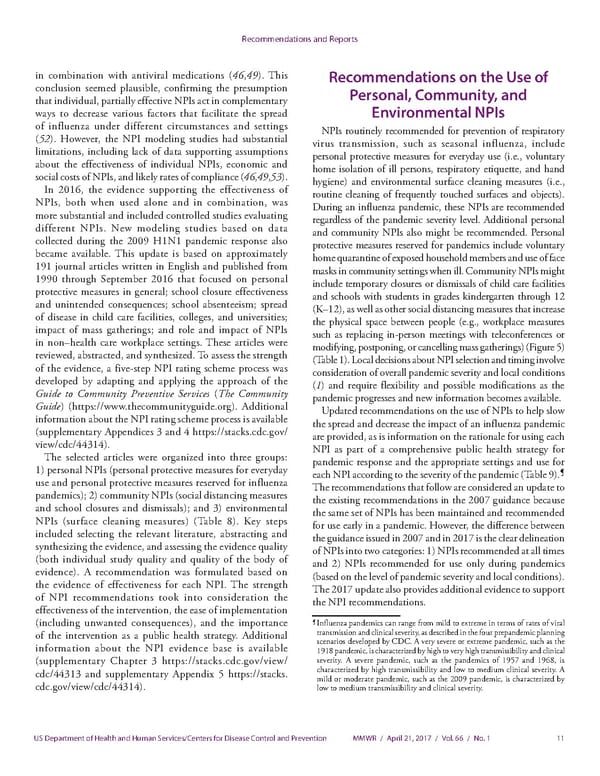Recommendations and Reports in combination with antiviral medications (46,49). This Recommendations on the Use of conclusion seemed plausible, confirming the presumption Personal, Community, and that individual, partially effective NPIs act in complementary ways to decrease various factors that facilitate the spread Environmental NPIs of influenza under different circumstances and settings NPIs routinely recommended for prevention of respiratory (52). However, the NPI modeling studies had substantial virus transmission, such as seasonal influenza, include limitations, including lack of data supporting assumptions personal protective measures for everyday use (i.e., voluntary about the effectiveness of individual NPIs, economic and home isolation of ill persons, respiratory etiquette, and hand social costs of NPIs, and likely rates of compliance (46,49,53). hygiene) and environmental surface cleaning measures (i.e., In 2016, the evidence supporting the effectiveness of routine cleaning of frequently touched surfaces and objects). NPIs, both when used alone and in combination, was During an influenza pandemic, these NPIs are recommended more substantial and included controlled studies evaluating regardless of the pandemic severity level. Additional personal different NPIs. New modeling studies based on data and community NPIs also might be recommended. Personal collected during the 2009 H1N1 pandemic response also protective measures reserved for pandemics include voluntary became available. This update is based on approximately home quarantine of exposed household members and use of face 191 journal articles written in English and published from masks in community settings when ill. Community NPIs might 1990 through September 2016 that focused on personal include temporary closures or dismissals of child care facilities protective measures in general; school closure effectiveness and schools with students in grades kindergarten through 12 and unintended consequences; school absenteeism; spread (K–12), as well as other social distancing measures that increase of disease in child care facilities, colleges, and universities; the physical space between people (e.g., workplace measures impact of mass gatherings; and role and impact of NPIs such as replacing in-person meetings with teleconferences or in non–health care workplace settings. These articles were modifying, postponing, or cancelling mass gatherings) (Figure 5) reviewed, abstracted, and synthesized. To assess the strength (Table 1). Local decisions about NPI selection and timing involve of the evidence, a five-step NPI rating scheme process was consideration of overall pandemic severity and local conditions developed by adapting and applying the approach of the (1) and require flexibility and possible modifications as the Guide to Community Preventive Services (The Community pandemic progresses and new information becomes available. Guide) (https://www.thecommunityguide.org). Additional Updated recommendations on the use of NPIs to help slow information about the NPI rating scheme process is available the spread and decrease the impact of an influenza pandemic (supplementary Appendices 3 and 4 https://stacks.cdc.gov/ are provided, as is information on the rationale for using each view/cdc/44314). NPI as part of a comprehensive public health strategy for The selected articles were organized into three groups: pandemic response and the appropriate settings and use for 1) personal NPIs (personal protective measures for everyday ¶ each NPI according to the severity of the pandemic (Table 9). use and personal protective measures reserved for influenza The recommendations that follow are considered an update to pandemics); 2) community NPIs (social distancing measures the existing recommendations in the 2007 guidance because and school closures and dismissals); and 3) environmental the same set of NPIs has been maintained and recommended NPIs (surface cleaning measures) (Table 8). Key steps for use early in a pandemic. However, the difference between included selecting the relevant literature, abstracting and the guidance issued in 2007 and in 2017 is the clear delineation synthesizing the evidence, and assessing the evidence quality of NPIs into two categories: 1) NPIs recommended at all times (both individual study quality and quality of the body of and 2) NPIs recommended for use only during pandemics evidence). A recommendation was formulated based on (based on the level of pandemic severity and local conditions). the evidence of effectiveness for each NPI. The strength The 2017 update also provides additional evidence to support of NPI recommendations took into consideration the the NPI recommendations. effectiveness of the intervention, the ease of implementation ¶ (including unwanted consequences), and the importance Influenza pandemics can range from mild to extreme in terms of rates of viral of the intervention as a public health strategy. Additional transmission and clinical severity, as described in the four prepandemic planning information about the NPI evidence base is available scenarios developed by CDC. A very severe or extreme pandemic, such as the 1918 pandemic, is characterized by high to very high transmissibility and clinical (supplementary Chapter 3 https://stacks.cdc.gov/view/ severity. A severe pandemic, such as the pandemics of 1957 and 1968, is cdc/44313 and supplementary Appendix 5 https://stacks. characterized by high transmissibility and low to medium clinical severity. A mild or moderate pandemic, such as the 2009 pandemic, is characterized by cdc.gov/view/cdc/44314). low to medium transmissibility and clinical severity. US Department of Health and Human Services/Centers for Disease Control and Prevention MMWR / April 21, 2017 / Vol. 66 / No. 1 11
 Community Mitigation Guidelines to Prevent Pandemic Influenza Page 12 Page 14
Community Mitigation Guidelines to Prevent Pandemic Influenza Page 12 Page 14